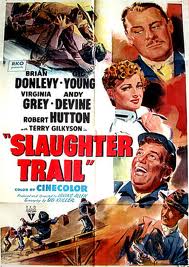
SLAUGHTER TRAIL
US, 1951, 78 minutes, Colour.
Brian Donlevy, Gig Young, Virginia Grey, Andy Devine, Robert Hutton, Terry Gilkyson.
Directed by Irving Allen.
The title, Slaughter Trail, gives the impression of being a tough western. In some senses, it is, featuring a stagecoach robbery, the death of the driver, an attack on an Indian home and the killing of two men, battles between the Navajo and the military.
However, this toughness is much lessened by the musical score and a continual use of songs. This seems anachronistic in the 21st century but there was a popularity in the 1940s for singing cowboys, especially Gene Autry. The film could be called a western musical or a musical Western, but is probably best described as a western with ballads.
While some of the songs are in the background, the screenplay provides for a military character, Singalong (Terry Gilkyson), to burst into song or to respond when asked to sing by his fellow troops. The songs have a jauntiness, often describing the action which is up there on the screen, especially the stagecoach, the outlaws, the robbery, the pursuit by the military. Other songs focus on the characters, on the humour in Fort Macy, New Mexico. There is also song for a dance at the Fort.
Gig Young is the leader of the outlaws, the Vaughan brothers, who hold up the coach, steal a purse of diamonds and entrust them to the woman passenger on the coach who turns out to be in league with them. The commander at the Fort is a rather crusty Brian Donlevy, a widower with his young daughter at the Fort. When the woman passenger wants to go on and is insulting, he forbids anyone to leave the Fort.
The complication arises when the outlaws’ horses’ ankles give way and they come upon an Indian home, shoot those who live there and steal their horses. One Indian survives and goes to the tribe, informing the chief, who had previously made a treaty of peace with the commander of the Fort. The chief demands revenge, a life for a life, while the commander tries diplomatic means, delay in the declaration of war.
The woman does persuade the commander to let her out but the coach is pursued by Indians and has to return to the Fort. In the meantime, the outlaws plan to get the diamonds allowing gig Young to go to the Fort where he also is interned because of the Indian threat.
The Indians attack – in the manner of the old-fashioned westerns, although 1950 was the year in which Broken Arrow appeared and set a different tone for depiction of Indians.
In the meantime, the woman has settled into the Fort, tries charm instead of aggression, befriends the commander’s daughter, helps with the children at the school – and, perhaps a bit quickly at times, romance, unlikely, blossoms.
It all comes to a head during the dance, the purse falling to the floor and the little girl finding it, the outlaw taking over, taking hostages. When the other men arrive, they are commandeered to help with fighting back the Indian attack. Needless to say, the three outlaws are killed – but the romance is not instantly fulfilled, the woman leaving for San Francisco - but probably returning.
Virginia Grey is the woman. And there is an amount of Fort comedy, especially about bravery and fear, from Andy Devine.
A B-feature, from its time, but entertaining on its way.